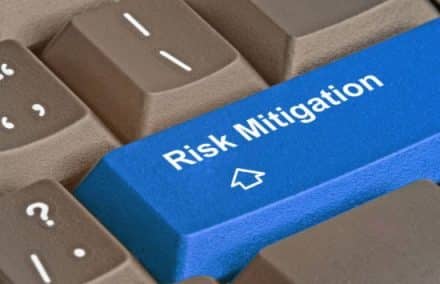What should you do if you discover a flaw in your company? Risk mitigation is the process of reducing hazards and ensuring resilience. In this post, we’ll define risk mitigation, go through some risk mitigation examples, show you how to start it, and explain who is in charge of managing and planning your risk mitigation strategy.
What is Risk Mitigation?
Risk mitigation is described as taking actions to reduce negative consequences. Four different types of risk mitigation measures are specific to Business Continuity and Disaster Recovery. It is critical to design a risk-mitigation strategy that is directly related to and reflects the profile of your firm.
Examples of Five Risk Mitigation Strategies
An appropriate risk mitigation strategy is first identifying potential project risks, such as team turnover, product failure, or scope creep. It is also about planning for the risk by applying solutions to reduce or eliminate the risk. One can utilize the examples below can in risk mitigation planning and monitoring.
- Accept and assume risk.
- Risk avoidance.
- Risk management.
- Transferring Risks.
- Watch and monitor the risk.
Read Also: Cost Reduction Strategies and Initiatives with Detailed Examples.
#1. Accept and assume risk.
The acceptance strategy may include team members working together to identify potential project risks. Also, they analyze it to see if the implications of those risks are acceptable. Along with identifying risks and their associated effects, team members may also identify and assume the potential vulnerabilities these risks provide.
This method is often used for identifying and analyzing the risks that can affect the output of a project. Its objective is to bring these risks to the attention of the business so that everyone working on the project has a shared awareness of the risks and repercussions associated. The example below demonstrates how the acceptance strategy can be implemented for commonly identified hazards.
One can use the acceptance strategy to detect cost-related concerns. For example, a project team may use the acceptance method to identify risks to the project budget. They may now develop measures to reduce the risk of going over budget. Thus, they ensure that all team members are aware of the risk and potential implications.
#2. Risks to the schedule
The accept technique may aid in identifying potential risks that may have an influence on schedule, such as maintaining the project on pace to fulfill deadlines.
These risks can include performance difficulties such as team productivity or product performance. They can also be identified and accepted as part of project planning. This is to ensure that all members are aware of potential performance hazards.
#2. Risk avoidance
The avoidance risk mitigation strategy outlines the project’s accepted and expected risks and effects, as well as chances to avoid those accepted risks. Some strategies of putting the avoidance risk mitigation strategy into action include planning for risk and then making efforts to prevent it. A project team, for example, may elect to perform product testing to prevent the risk of product failure before permitting final production to mitigate risk on new product manufacturing. Other approaches to implementing avoidance risk mitigation strategies are provided in the examples below.
Read Also: Compensation Plan: Best United States Practices (Updated).
#1. Performance risk
Mitigation of performance risks, such as insufficient resources to complete the task, insufficient design, or bad team dynamics, can enable a project team to discover alternative ways to prevent these types of risk situations that may cause project performance concerns. A production team, for example, may test more robust product materials to prevent the risk of product failure with less durable materials. Similarly, if there is a risk of poor performance within the project team dynamics, you can use interactive team management to avoid problems.
#2. Schedule risk
Avoiding schedule implications can be accomplished by detecting potential issues that could disrupt the project’s timeline. Risks, such as being too enthusiastic about a project’s timeframe, can have an impact on important deadlines, due dates, and ultimate delivery dates.
The avoidance risk mitigation strategy can assist the project team in designing solutions to prevent schedule conflicts, such as generating a managed schedule that demonstrates exact time allowances for planning, design, testing, and retesting, as well as making modifications as needed. Non-working hours could also be organized to avoid time management concerns.
Another use of this method is the avoidance of expense difficulties. A project team, for example, may detail all projected expenditures as well as account for any costs that may arise so that the implications of going over budget can be avoided.
#3. Risk management
When mitigating project risks, team members may also apply a control approach. This technique works by identifying and accepting risks and then making efforts to mitigate or eliminate their consequences. The following examples demonstrate how risk-mitigation control planning can be applied.
#1. Cost-cutting measures
A project team may implement control mechanisms that might detect potential budget difficulties. Controls for risk mitigation may include, for example, a focus on management, the decision-making process, or identifying weaknesses in the project’s finance before problems develop. This can also provide a project team with insight into how they distribute funds and if there is a risk of going over budget, the team can identify this before it occurs and take measures to control it, such as reducing spending or eliminating a resource that may prove too costly for the project.
#2. Controlling the risk to schedule
Scheduling implications can be mitigated by distributing tasks and also the time required to perform them across the project team. Control methods could include recording the amount of time it takes to accomplish each activity and assigning specific assignments to team members based on the amount of time involved in each task. To help control any risks to the project schedule, the project team may additionally consider time management measures.
#3. Managing the risk to performance
Implementing performance risk control tactics might include ways for directing a team’s daily work, quality control procedures for new products, and measures for taking action to control issues that could affect overall project performance.
#4. Transferring of Risks
When risks are understood and considered, reducing the repercussions through transference can be an effective method. The transference approach works by transferring the strain of another party’s risk and repercussions. However, this has its own set of limitations, and when an organization applies this risk mitigation method, it should do so in a way that is acceptable to all stakeholders involved. The following example demonstrates how and when you can employ risk mitigation measures.
Read Also: Are Exam Dumps and Practice Tests Really Helpful for Certbolt Microsoft MS-900 Exam?
#1. Performance transference
If, for example, a production team creates a new product yet the end result contains flaws. The faults may not be directly caused by production issues, but rather by issues with materials obtained from a third party.
So, the production company may choose to bear the consequences and pursue resolution strategies such as product recall, or it may choose to transfer the consequences to the outside vendor responsible for providing the product materials by requiring the vendor to bear the costs associated with the product defects.
#2. Transfer for scheduling purposes
While project delays are a risk in and of themselves, transference tactics can be utilized to move the cost of being behind schedule to team members accountable for time management rather than the firm as a whole. With the implications delegated to the team members in charge of scheduling, the production team, design team, or others can concentrate on completing the remainder of their jobs.
#3. Cost transferring
Cost consequences might be transferred by holding accountants and financial advisors accountable for budgeting mistakes. For example, the implications of a project going over budget can include increased production costs and material funding. If the implications are delegated to the finance teams in charge of budget tracking, production managers and team members can focus on their jobs while the finance team works to resolve cost issues.
#5. Watch and monitor the risk.
Monitoring projects for risks and repercussions entails keeping an eye out for and also recognizing any changes that may have an impact on the risk’s impact. This method of risk mitigation could also be used by production teams as part of a typical project review process. Cost, timing, and project performance or productivity are all factors of a project that can be monitored for risks that may arise throughout project completion. The following example shows how to monitor and evaluate risks and consequences that may affect the completion of a project.
#1. Cost Monitoring
A finance team or budget committee can examine and also manage cost concerns by developing a reporting routine that details each company’s expenditure. So, this technique works by allowing teams to constantly evaluate the budget and adjust any cost projections as needed.
#2. Schedule for monitoring
Weekly updates to evaluate each team member’s tasks and how long it takes them to accomplish each task might be included in project monitoring schedules. The team can then analyze and track any difficulties that may cause the project to slip behind schedule. Calendars and project management tools, for example, can aid in the monitoring and evaluation of time management and project schedules.
#3. Performance evaluation
Monitoring the performance of products, team members, and also resources utilized to execute a project are all examples of how performance monitoring can be implemented. Evaluating and reviewing many areas of a company’s performance can assist limit risks of a drop in performance, and technologies such as productivity software can help track and evaluate performance procedures inside the project. Employee performance may be tracked by planning and implementing frequent performance assessments, and product performance can be tracked by conducting continuous product testing and review.
Mitigating financial risk
We need money to survive on a daily basis. We also need it to be prepared for the possibility of a major life event requiring a large sum of money be put forward, and for when old age prevents us from being able to earn money through a job. In order to stay financially secure, we may decide to:
- Max out our retirement savings
- Keep an emergency fund in a liquid savings account
- Pay cash for everything to ensure we’re not buying anything we cannot afford
Risk mitigation in personal relationships
Positive personal relationships bring fulfillment to our lives, and like everything else we need to actively maintain the quality of those relationships to keep them from falling apart. Here are some examples of those nurturing efforts:
- Treating those we love with kindness and respect
- Consistently calling, sending cards and visiting
- Cutting out relationships with people who don’t treat us well (in order to make more time for those that do)
Mitigating the risk of health problems
Our health is the foundation of our lives, so it’s critical to take proper measures of ensuring it. While there are infinite ways to maximize our health and minimize the risk of serious problems, here are just a few of the most common mitigation activities:
- Drinking plenty of water (the recommended amount for our body size)
- Staying away from toxic behaviors like smoking, drinking or eating processed foods
- Exercising regularly
Depending on how important certain areas of your life are to your overall identity and well-being, you may formalize your mitigating activities or not. For some, saving money, nurturing relationships, and staying healthy comes with ease and requires no structured plan to stay on track. For others, making a budget sheet, filling up a calendar with social events, or sticking to a recommended diet is critical for holding everything together.
What role do insurance and other financial instruments play in risk mitigation?
Insurance and financial instruments play a crucial role in risk mitigation. They provide companies with a way to transfer or reduce their risk to other parties, such as insurance companies or investors. For example, insurance policies can provide financial protection against losses from various risks, such as property damage, theft, or liability. Other financial instruments, such as bonds, can help a company raise capital to fund risk mitigation activities. By using these tools, companies can reduce their overall exposure to risk and increase their financial stability.
How can a company evaluate and select risk mitigation strategies?
To evaluate and select risk mitigation strategies, companies should consider several factors. These may include the potential impact of a particular risk, the likelihood of the risk occurring, and the costs and benefits of various mitigation options. Companies may also need to consider the compatibility of a mitigation strategy with their existing systems and processes, as well as the resources available to implement the strategy. Ultimately, the selection of a risk mitigation strategy will depend on the specific needs and goals of the company, as well as the risks that it faces.
What are the key success factors for effective risk mitigation?
Effective risk mitigation requires careful planning and implementation. Key success factors for risk mitigation include: a comprehensive risk assessment, a well-designed risk mitigation plan, the right resources, and continuous monitoring and review. Additionally, companies should engage all relevant stakeholders in the risk mitigation process, including employees, customers, and suppliers. Effective communication is also crucial, as is a clear understanding of the benefits of risk mitigation and the role that everyone plays in achieving success.
How does a company determine its risk tolerance?
A company’s risk tolerance is the level of risk it is willing to accept in pursuit of its goals and objectives. Determining a company’s risk tolerance involves evaluating its overall financial situation, its risk management capabilities, and the potential impact of various risks on its operations and financial stability. Companies may use various methods, such as risk surveys and simulations, to assess their risk tolerance and determine the most appropriate risk mitigation strategies.
Conclusion
The ultimate goal is to protect your organization. Your top dangers and concerns must also be addressed on a regular basis to guarantee that you are fully protecting them.
Furthermore, you are removing areas that you can control if you do not invest in risk reduction. As a result, you are completely subject to the effects of external factors. While we can accomplish success in our personal lives by simply intuitively avoiding risk, going above and beyond in our enterprises is crucial.
To maximize your company’s full potential, begin by focusing your efforts on risk mitigation.
Risk Mitigation FAQs
Why is risk mitigation important?
Risk mitigation is important to stop risks from turning into issues that can affect business operations and negatively impact the bottom line. … If you look to be carrying a lot of risk without strong risk mitigation strategies, they may be less interested in working with you.
What is risk mitigation examples?
Risk mitigation revolves around reducing the impact of potential risk. A jewelry store might mitigate the risk of theft, by having a security system or even a security guard at the entrance.
How do you mitigate risk control?
Let’s talk about four different strategies to mitigate risk: avoid, accept, reduce/control, or transfer.
- Avoidance. If a risk presents an unwanted negative consequence, you may be able to completely avoid those consequences. …
- Acceptance. …
- Reduction or control. …
- Transference. …
- Summary of Risk Mitigation Strategies.
What is another word for risk mitigation?
On this page, you can discover 15 synonyms, antonyms, idiomatic expressions, and related words for mitigation, like reduction, relief, alleviation, palliation, increase, remission, moderation, extenuation, remediation, mitigate, and risk-reduction.
- Risk Mitigation Strategies: Four Common Strategies with Examples.
- Risk Management Plan: 5 Simple Steps & All You Need
- Employee Schedule: Types & Best 5 Employee Work Schedule Apps
- Financial Performance: A Comprehensive Guide For Any Business(+ quick tools)
- Work Schedule: Steps to Schedule Employees Effectively






